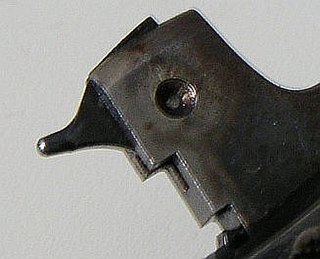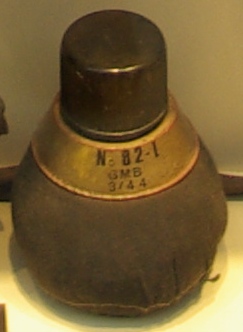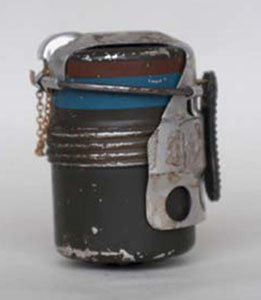An explosive booster is a sensitive explosive charge that acts as a bridge between a conventional detonator and a low-sensitivity explosive such as TNT. By itself, the initiating detonator would not deliver sufficient energy to set off the low-sensitivity charge. However, it detonates the primary charge, which then delivers an explosive shockwave that is sufficient to detonate the secondary, main, high-energy charge.

A shell, in a military context, is a projectile whose payload contains an explosive, incendiary, or other chemical filling. Originally it was called a bombshell, but "shell" has come to be unambiguous in a military context. A shell can hold a tracer.

"Mills bomb" is the popular name for a series of British hand grenades which were designed by William Mills. They were the first modern fragmentation grenades used by the British Army and saw widespread use in the First and Second World Wars.

Stielhandgranate is the German term for "stick hand grenade" and generally refers to a prominent series of World War I and World War II–era German stick grenade designs, distinguished by their long wooden handles, pull cord arming and cylindrical warheads. The first models were introduced by the Imperial German Army during World War I and the final design was introduced during World War II by the German Wehrmacht.

A firing pin or striker is a part of the firing mechanism of a firearm that impacts the primer in the base of a cartridge and causes it to fire. In firearms terminology, a striker is a particular type of firing pin where a compressed spring acts directly on the firing pin to provide the impact force rather than it being struck by a hammer.

The Gammon bomb, officially known as the No. 82 grenade was a British hand grenade used during World War II.

The Grenade, Rifle No. 68 / Anti-Tank was a British anti-tank rifle grenade used during the Second World War and was one of the first operational weapons to utilise the shaped charge principle.

The No. 73 grenade, also known as the "Thermos", "Woolworth bomb", or "hand percussion grenade", was a British anti-tank grenade used during the Second World War. It got its nickname from the resemblance to a Thermos flask.
The military of the United States has used many different types of hand grenades since its foundation.

An anti-handling device is an attachment to or an integral part of a landmine or other munition such as some fuze types found in general-purpose air-dropped bombs, cluster bombs and sea mines. It is designed to prevent tampering or disabling, or to target bomb disposal personnel. When the protected device is disturbed, it detonates, killing or injuring anyone within the blast area. There is a strong functional overlap of booby traps and anti-handling devices.

The HG 85 is a round fragmentation hand grenade designed for the Swiss Armed Forces, and is still produced by RUAG Ammotec in Switzerland. HG 85 is the internal designation of the Swiss Army and replaced the HG 43 from World War II.
In military munitions, a fuze is the part of the device that initiates its function. In some applications, such as torpedoes, a fuze may be identified by function as the exploder. The relative complexity of even the earliest fuze designs can be seen in cutaway diagrams.

A grenade is an explosive weapon typically thrown by hand, but can also refer to a shell shot from the muzzle of a rifle or a grenade launcher. A modern hand grenade generally consists of an explosive charge ("filler"), a detonator mechanism, an internal striker to trigger the detonator, an arming safety secured by a transport safety. The user removes the transport safety before throwing, and once the grenade leaves the hand the arming safety gets released, allowing the striker to trigger a primer that ignites a fuze, which burns down to the detonator and explodes the main charge.

An artillery fuze or fuse is the type of munition fuze used with artillery munitions, typically projectiles fired by guns, howitzers and mortars. A fuze is a device that initiates an explosive function in a munition, most commonly causing it to detonate or release its contents, when its activation conditions are met. This action typically occurs a preset time after firing, or on physical contact with or detected proximity to the ground, a structure or other target. Fuze, a variant of fuse, is the official NATO spelling.
The Frangible Grenade M1 was a specially designed factory produced molotov cocktail created by the United States in 1942 as it entered World War II (1939–1945). It was designed to provide lightly armed personnel with simple, uncomplicated weapons that were easy to mass-produce. It provided a cheap stopgap means of knocking out enemy vehicles, clearing out strongpoints, and harassing or killing enemy personnel until more effective weapons could be produced and distributed. It was dubbed "frangible" because it was made from glass, which is brittle and easily broken.

The OTO Mod. 35 was a hand grenade issued to the Regio Esercito during World War II.

The SRCM Mod. 35 is a hand grenade that was first issued to the Royal Italian Army in 1935, serving through World War II and into the 1980s. Nicknamed "Red Devils" by the British in 1941–1942 during the North African Campaign after the red color of the most common type.

The Shitotsubakurai or lunge mine was a suicidal anti-tank weapon developed and used by the Empire of Japan during the Second World War. It used a HEAT type charge. This weapon was used by the CQC units of the Imperial Japanese Army. The weapon itself was a conical hollow charge anti-tank mine, placed inside a metallic container and attached to the end of a wooden stick. The weapon was officially adopted by the Japanese Army in 1945; in that year it caused its first victims in the Pacific Theater, where it commonly saw action against American armour. Later that year, some Japanese Imperial Army manuals of the weapon were discovered by US troops.

The Sprengpatrone or "explosive cartridge" in English was a rifle grenade that was developed by Germany and used by the Wehrmacht during World War II. The Sprengpatrone was designed to be fired from a Kampfpistole flare gun.

The Garland grenade was a grenade and trench mortar bomb developed and used by British Empire forces in the First World War. It was invented by the metallurgist Herbert Garland at the Cairo Citadel, and more than 174,000 were issued to the Mediterranean Expeditionary Force. The grenade was also used during the Arab Revolt. The Mark I grenade was relatively primitive, being formed of an explosive-filled food tin with a fuse that was lit with a match. The Mark II version was made of cast iron and could be fired from the Garland Trench Mortar.
















